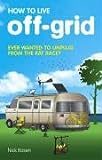
Don’t try this at home A high profile story about living off-grid in the UK appeared in New Scientist magazine. Its riddled with errors.
Titled ‘How to unplug from the grid,’ it couldn’t be a bigger plug for off-grid living, if you’ll excuse the pun. But the New Scientist cover story has sparked a furious debate about numerous inaccuracies in both the story and the accompanying picture.
The New Scientist editorial team for some reason chose to illustrate “How to unplug from the grid” with a photo (left) of a woman ironing laundry in a field, powered by a single solar panel in the foreground. What these science experts failed to appreciate was that it is quite impossible to run an iron off-grid using a solar panel other than by a major leap in solar technology. The panels would need to achieve something like 70% efficiency compared to the current 14% from the best panels, according to the scientists who crowded the comment section of the web site. One called it “an outright lie.” Unless the New Scientist knows something we don’t, and has failed to mention in the article, then running an iron from a solar panel would be a major breakthrough of global proportions; in which case, we want some of those panels!
At least one of the interviewees feels he was portrayed inaccurately in the story:“I am a Hydro expert not forestry,” writes Mike Bestwick of Aberdeenshire. Oh, and another small point. Mike does not actually live off-grid.
“He has the grid for backup” says the writer, Gaia Vince. Nothing wrong with that, but you would have thought the New Scientist could go to the trouble of finding people who are actually off-grid for their story about unplugging from the grid. There are plenty about — many more than the 40,000 homes they wrongly claim in the article, although no source is given. According to the UK government the true figure is at least two and a half times that.
Best source
Mike Bestwick lists numerous other factual errors — nothing important – just small technical errors, the sort of thing you would have thought the New Scientist (which is about to have its staff numbers cut by owners Reed/Elsivier) would ensure it got right:
“ …the wheel is not galvanised and was designed by myself,” writes Bestwick, “and constructed by my local blacksmith and I, from 50% recycled materials,and it averages 20,000kWh/annum of output,not 4,000 as stated.”The article revisits people first mentioned in Nick Rosen’s book, HOW TO LIVE OFF GRID. If you read the article and want to know more about Tony Marmont (anyone interested can find a more detailed account of his set-up there), Richard Perez and other leading edge off-gridders, then do visit this web site more often, or buy the book (click on the link to the right).
“How to unplug from the Grid” is a great little intro to the subject despite the shoddy journalism. Subscribe to www.off-grid.net for the real deal and regular updates.

2 Responses
Veg-Head versus the New Scientist…..hmmmm, i wonder which one to side with? This chap, or woman, has obviously really got vegetables inside their head.
Living off the grid obviously does not appeal to everybody, and if you really do want to try to persuade large groups of people to become more environmentally responsible it will take more than silly websites like this one, and crazy hippies like this veg-head who clearly can’t see things from the perspective of the majority.
Why don’t we get rid off all the big bad companies, and return to the forests?
PS, I love meat! Grrr. You can keep your vegetables, stick them where the sun does not shine.
I too read this article, and I was slightly amused by the photo depicting someone using an iron that was powered solely by the sun. It was absurd…but there was no pretence that it was anything else. It must be understood that the New Scientist is written FOR scientists or those people who have a healthy interest in science, NOT for the general public – although, to be fair, much of the publication is written in such a way that much of its content should be understood by most readers. To put this in context, we must consider the solar irradiance at the earth’s surface, or the amount of power originating from the sun that falls on each square meter of the earth (ref: Wikipedia/Sunlight). This value is approximately 120 watts/sq metre. Now, the iron I use has a power rating of 1200 watts, meaning that I would need to collect the sun’s energy from a total surface area of 10 square meters, IF I had a conversion efficiency of 100% ! This is certainly not the case. Assuming a conversion efficiency around 20% (feasible but currently expensive), we would need a surface are of 50 square meters! That’s approximately the floor area of my lounge, where I am writing this. And that’s assuming that the sun is directly overhead and there are no clouds. Not always the case in the UK.